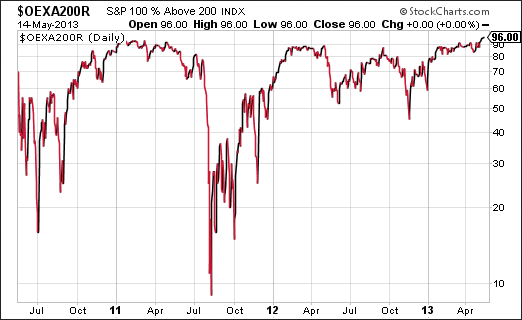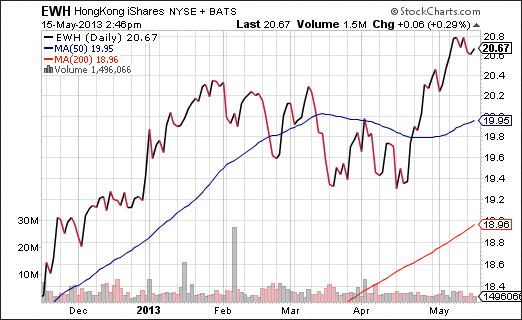“I’ve never seen THIS in 34 years of investing,” quipped media personality Jim Cramer on Monday. What was Mr. Cramer referring to? For the most part, he expressed excitement over the stock market’s ability to reward stocks of companies that missed earnings expectations as well as to reward those that beat expectations by not taking profits. In other words, regardless of what a corporation has already achieved or anticipates achieving going forward, investors are buying indiscriminately.
Uptrends Break
Need proof that everything is a winner? Take a look at a three-year chart involving the S&P 100. In bullish rallies, one expects the majority of stocks in a major index like the S&P 100 to gain ground in an uptrend. The percentage of S&P 100 stocks that climb above and stay above a long-term 200-day trendline might be 70%, 80%, maybe even 90%.
Eventually, uptrends break down. In the first four months of April, 2011, the percentage of S&P 100 stocks that remained above a 200-day average hovered around 90%. Then the levy broke and the iShares S&P 100 Index Fund (OEF) forfeited 18% from the highs to the lows. In 2012, 90% of S&P 100 stocks remained above a 200-day trendline as well. When the “sell-in-May” crowd exerted their influence, OEF had logged 8% in losses in roughly six weeks.
Strange Things
Historically, when 90% of stocks are above key long-term trendlines, one is typically looking at overbought conditions. Yet those conditions can persist for many months. Here in 2013, however, I am witnessing oddities that I have not personally witnessed during my 23 years of experience. Not only have we been hovering around the 90% level for most of 2013, but in the last few weeks, the percentage has climbed even higher. We’re now looking at 96% of stocks in long-term uptrends.
This “96%” goes a long way toward describing Mr. Cramer’s anecdotal observations. Specifically, investors are neither punishing the poor performers nor “cashing in” on the good performers.
Where I differ with Mr. Cramer, and a number of uber-bullish commentators, is the idea that the current market conditions should be embraced. “Buy, buy, buy!” To that I would answer, “Why, why, why?”
Pullbacks Are Inevitable
I do not know when the markets will decide that 1% revenue growth eventually hinders future earnings. I cannot predict when short sellers and profit takers will make bearish prognosticators appear brilliant. And I certainly do not know if Europe’s deepening recession or the next Fed statement or the ongoing currency wars will be at the root of the next stock market correction. Nevertheless, pullbacks are as inevitable as a disgruntled relative complaining at a family get-together. It’s going to happen.
I recommend that an ETF enthusiast put together a list of stock ETFs that he/she would like to own, if the prices were 5%, 10% and/or 15% lower. At a 5% discount from current prices, I like investments such as iShares High Dividend Equity (HDV), iShares MSCI Emerging Market Minimum Volatility (EEMV) and GlobalX Super Dividend (SDIV). At a 10% discount from current prices, I might consider broader market assets like iShares Mid Cap Value (IWS), WisdomTree MidCap Dividend (DON) and iShares MSCI Hong Kong (EWH).
And at a 15% discount, when one needs to recognize the genuine possibility of a correction becoming a ferocious bear, I may be keen on those stock ETF assets that held up significantly better under fierce volatility and negativity. In all instances, I will employ stop-limit loss orders to protect against the possibility that losses accelerate.
- English (UK)
- English (India)
- English (Canada)
- English (Australia)
- English (South Africa)
- English (Philippines)
- English (Nigeria)
- Deutsch
- Español (España)
- Español (México)
- Français
- Italiano
- Nederlands
- Português (Portugal)
- Polski
- Português (Brasil)
- Русский
- Türkçe
- العربية
- Ελληνικά
- Svenska
- Suomi
- עברית
- 日本語
- 한국어
- 简体中文
- 繁體中文
- Bahasa Indonesia
- Bahasa Melayu
- ไทย
- Tiếng Việt
- हिंदी
Unsupportable Fervor Requires an ETF Wish List
Published 05/15/2013, 03:52 PM
Updated 03/09/2019, 08:30 AM
Unsupportable Fervor Requires an ETF Wish List
Latest comments
Loading next article…
Install Our App
Risk Disclosure: Trading in financial instruments and/or cryptocurrencies involves high risks including the risk of losing some, or all, of your investment amount, and may not be suitable for all investors. Prices of cryptocurrencies are extremely volatile and may be affected by external factors such as financial, regulatory or political events. Trading on margin increases the financial risks.
Before deciding to trade in financial instrument or cryptocurrencies you should be fully informed of the risks and costs associated with trading the financial markets, carefully consider your investment objectives, level of experience, and risk appetite, and seek professional advice where needed.
Fusion Media would like to remind you that the data contained in this website is not necessarily real-time nor accurate. The data and prices on the website are not necessarily provided by any market or exchange, but may be provided by market makers, and so prices may not be accurate and may differ from the actual price at any given market, meaning prices are indicative and not appropriate for trading purposes. Fusion Media and any provider of the data contained in this website will not accept liability for any loss or damage as a result of your trading, or your reliance on the information contained within this website.
It is prohibited to use, store, reproduce, display, modify, transmit or distribute the data contained in this website without the explicit prior written permission of Fusion Media and/or the data provider. All intellectual property rights are reserved by the providers and/or the exchange providing the data contained in this website.
Fusion Media may be compensated by the advertisers that appear on the website, based on your interaction with the advertisements or advertisers.
Before deciding to trade in financial instrument or cryptocurrencies you should be fully informed of the risks and costs associated with trading the financial markets, carefully consider your investment objectives, level of experience, and risk appetite, and seek professional advice where needed.
Fusion Media would like to remind you that the data contained in this website is not necessarily real-time nor accurate. The data and prices on the website are not necessarily provided by any market or exchange, but may be provided by market makers, and so prices may not be accurate and may differ from the actual price at any given market, meaning prices are indicative and not appropriate for trading purposes. Fusion Media and any provider of the data contained in this website will not accept liability for any loss or damage as a result of your trading, or your reliance on the information contained within this website.
It is prohibited to use, store, reproduce, display, modify, transmit or distribute the data contained in this website without the explicit prior written permission of Fusion Media and/or the data provider. All intellectual property rights are reserved by the providers and/or the exchange providing the data contained in this website.
Fusion Media may be compensated by the advertisers that appear on the website, based on your interaction with the advertisements or advertisers.
© 2007-2025 - Fusion Media Limited. All Rights Reserved.
